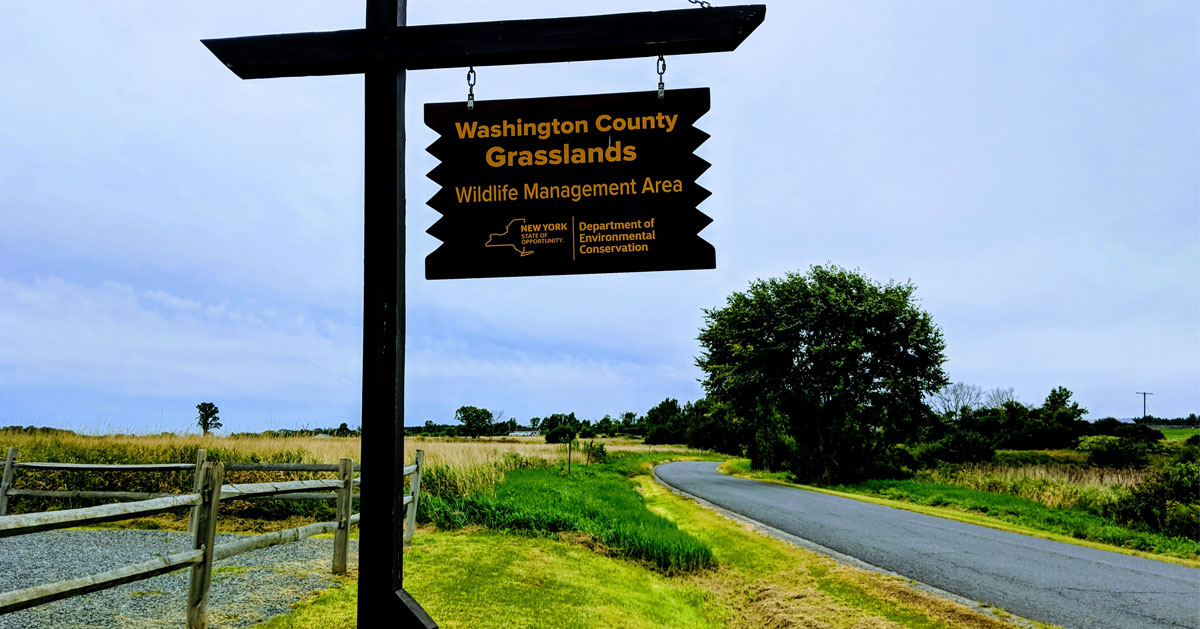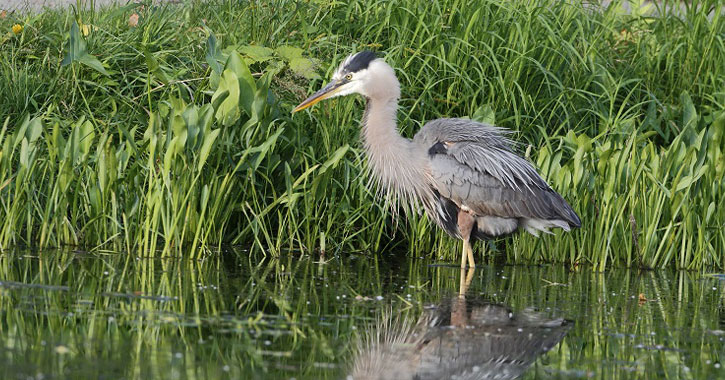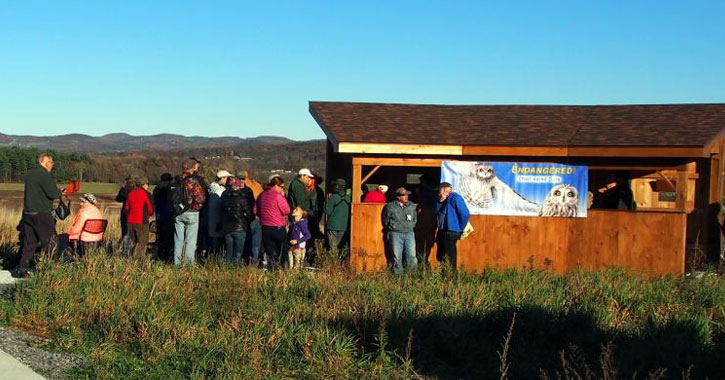Take a Walk on the Wild Side: Go Birding, Explore Nature & Help Our Local Bird Species
Our region of Upstate New York is home to a wide variety of species, and a number of conservation areas, nature preserves, and wildlife management areas designed to preserve and protect their habitats.
Ready to get out there and explore? There are a number of great spots, particularly in Washington County, where you can enjoy hiking, birding, and observing wildlife. Learning more about our local species by seeing the animals in their own habitat is an excellent approach to paving the way for further education on these amazing creatures. There’s even an upcoming festival you just won’t want to miss!

Why It's Important to Preserve Wildlife in Their Natural Habitat
There are many species listed as endangered or at risk in Upstate New York, such as short-eared owls, which used to be one of the most common owls and now number less than 100. More and more species are forced out of their natural habitats through industrialization and deforestation, causing a domino effect on the local ecosystem.
Grassland birds like the short-eared owl, northern harrier, upland sandpiper, and many others feed on rodents and insects that destroy local crops – this is one reason why it’s so important to keep their habitats intact, because if we don’t, it will have a detrimental effect on local agribusinesses and even the economy.
When our animals, land, water, and plants work together in a healthy ecosystem everyone, including humans, benefits. But it’s up to us to protect this community.
Where to Enjoy Nature, Go Birding & See Wildlife in Their Natural Habitats
Wondering where to go to see grassland birds, songbirds, and more?
Keep an eye out – and an ear out! – for birds at the following nature areas. Remember, just because you might not be able to see a bird doesn’t mean you can’t listen for their specific sounds and calls and identify who is around based on what you hear. Consider downloading a birding app for your phone or purchasing a guide book before you head out. And of course, watch out for other wildlife as well!
The Washington County Grasslands Wildlife Management Area

One of the prime places to enjoy a variety of different bird species, including many endangered or otherwise threatened species, is the Washington County Grasslands in Fort Edward. The Washington County Grasslands consists of 13,000 acres of fields and meadows, and the Washington County Grasslands Important Bird Area (IBA) makes up about 2,000 of those acres in the heart of these grasslands.
The public is welcome to visit the Washington County Grasslands IBA to view, enjoy, and photograph the wildlife without disturbing them. There is a half-mile trail that gives visitors a prime chance to see and hear the birds.
Here, you can see the following species: short-eared owls, snowy owls, northern harriers, upland sandpipers, horned larks, eastern meadowlarks, American kestrels, vesper sparrows, grasshopper sparrows, and sedge wrens – several of these species are listed as endangered, threatened, or are otherwise considered to be at risk, particularly the short-eared owl.
The best viewing area to see wintering raptors in particular, like the short-eared owl and snowy owl, is the Alfred Z. Solomon Grassland Bird Viewing Area, which is part of the Washington County Grasslands IBA.
Carters Pond Wildlife Management Area

Photo credit: Alan Nudi
Managed by the DEC, Carters Pond Wildlife Management Area encompasses 400 acres and includes a large pond surrounded by fields and woods and is located in Greenwich.
The pond is popular for fishing, including ice fishing in the winter, and it also attracts a variety of different kinds of ducks, geese, woodpeckers, and migratory songbirds. There is a mile-long nature trail and an observation tower.
Chubbs' Dock

Chubbs’ Dock is situated in Clemons, on the southern part of Lake Champlain, and offers prime wildlife viewing opportunities in addition to scenic views of the lake. Here you can find wading birds like the great blue heron, American bittern, least bittern, kingfisher, and you might get to glimpse a bald eagle or osprey. This area is also managed by the DEC.
Lake Champlain South Bay

Photo credit: NYS DEC
Lake Champlain South Bay is just north of Whitehall and offers a great chance to see migratory waterfowl like ospreys, great blue herons, belted kingfishers, sandpipers, and other shorebirds. Bald eagles and golden eagles can also be seen here, if you’re lucky!
Both Chubbs’ Dock and the Lake Champlain South Bay are best explored by canoe or kayak, so if you’re a paddler who is interested in getting into birding, these could be some great places to start! Chubbs’ Dock has a state boat launch and Lake Champlain South Bay has a public boat launch.
Schumann Preserve at Pilot Knob

This 223-acre preserve is located on the eastern side of Lake George. You can embark on a moderate hike that ends at the preserve’s gazebo that offers really expansive views of Lake George and the Adirondacks.
There is also a second trail that goes through forests and grassy meadows and if you’re lucky, you’ll get to see a waterfall – the waterfall is typically active in the spring.
The Schumann Preserve at Pilot Knob is owned by the Lake George Land Conservancy, which works to protect the quality of water in the lake as well as the land within the Lake George watershed.
East Bay Wildlife Management Area
East Bay Wildlife Management Area in Whitehall is 38 acres and is identified as a Bird Conservation Area (BCA), which means it is state-owned and designated to safeguard and strengthen bird populations. It’s managed by the DEC’s Division of Fish and Wildlife for conservation and related recreation, such as photography or wildlife viewing.
The area is situated in a narrow river valley surrounded by steep hills and a scenic ledge, and the majority of the land is considered to be an emergent marsh. Emergent marshes are areas that have about six inches of water during the growing season, or possibly longer.
Hiking is allowed on designated trails and you’ll be able to see a variety of wildlife, including birds. In the spring and summer many birds rely on this area for breeding, food, and shelter. Some winter here as well.
Goose Egg State Forest & Battenkill State Forest
You can find Goose Egg State Forest and Battenkill State Forest right next to each other in the towns of Jackson and White Creek, close to the Vermont border. Goose Egg State Forest is 535 acres and Battenkill is 436.
The Folded Rock Trail, a five-mile roundtrip trail, goes through both forests. Hikers cross a small stream, go through the forest, and at the end of the trail, there is a vantage point that allows for a stunning view of the Battenkill River Valley.
Each forest consists of a variety of wildlife including game species like deer and fox, as well as a range of songbirds.
Pember Nature Preserve
You’ll get a two-for-one deal if you visit the Pember Nature Preserve in Granville – it’s owned by the neighboring Pember Library and Museum, which is a really awesome and unique museum where you can see over 9,000 different specimens of birds and other animals.
The Pember Nature Preserve encompasses 125 acres of forest, wetland, and fields and includes over two miles of trails that range from an easy walk to a moderate hike. There’s also an observation platform at the edge of a creek that allows you to observe the wetland wildlife.
Conservation Groups & How They Help Our Wildlife
Grassland Bird Trust

The Grassland Bird Trust (formerly the Friends of IBA) is a nonprofit committed to the education about and protection of endangered, threatened, or at risk birds of the Washington County Grasslands.
Currently, they own 14 acres of habitat of the Washington County Grasslands IBA, and holds a conservation agreement on an additional 50 acres adjacent to it. They’re working to obtain even more acres to better protect our birds.
Part of the way this group works towards the goal of protecting birds of the grasslands and preserving their habitat is through outreach events, so be sure to follow them to see what's happening!
Battenkill Conservancy
The Battenkill Conservancy is a nonprofit organization that works to promote open space and clean water in the Battenkill watershed, and to preserve the overall area.
Specifically, they have a multi-year plan with two primary objectives: One, to protect the land along the Battenkill River corridor and its tributaries, including restoration of degraded aquatic and riparian habitats, and two, to increase ecological awareness among local groups to safeguard and protect the river.
They engage in environmental cleanups and a wide variety of significant programs like a school river watch program, youth education and outdoor programs, community educational programs, and much more.
Cornell Cooperative Extension of Washington County
Cornell Cooperative Extension of Washington County is one of many CCEs operating under Cornell University, all of which have an educational mission to improve the lives of local communities through various partnerships.
One of the many ongoing projects the CCE of Washington County engages in is to respond to important environmental challenges in the local area. This could include anything from stream reconstruction and stream management after flooding, to woodlot management, which involves the maintenance of small forests or woodlands.
Another important environmental issue CCE of Washington County deals with is invasive species, both animals and plants. Working actively to combat these species is significant to preserving our local environment.